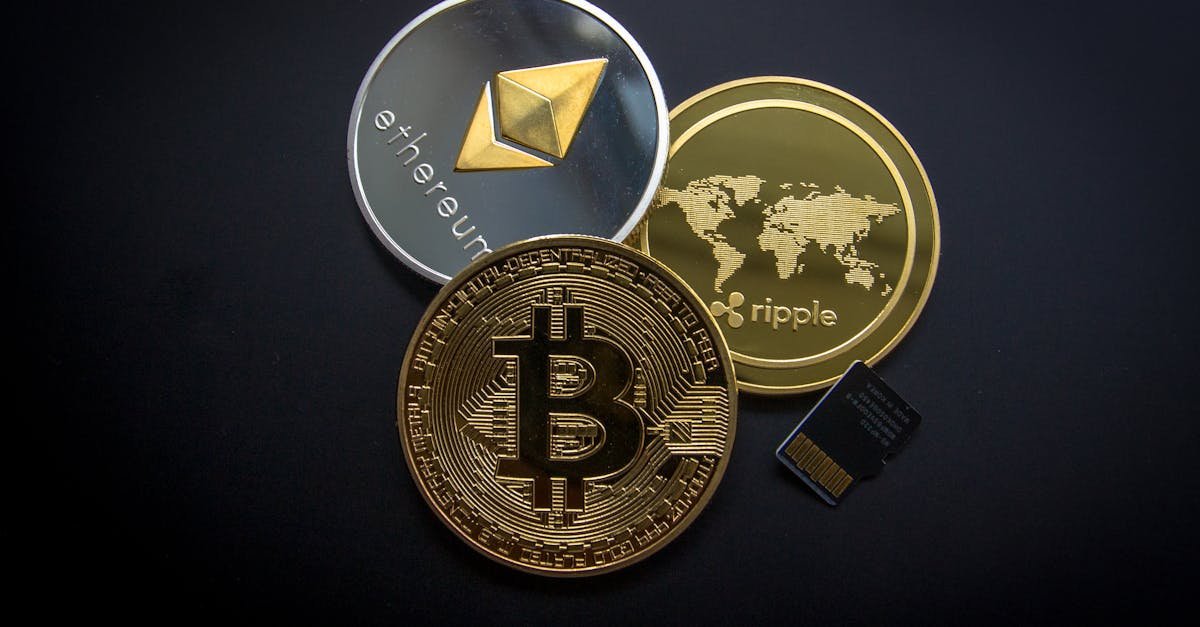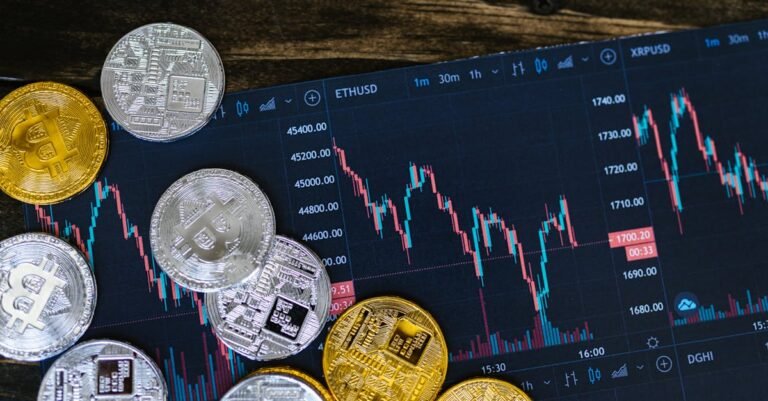How to Create a Balanced Altcoin Portfolio: Your Guide to Smarter Crypto Investing
Ever feel like the crypto world is moving at lightning speed? One minute everyone’s talking about Bitcoin, the next there are thousands of other coins, called altcoins, popping up. It’s exciting, maybe a little overwhelming, and definitely full of potential. But diving headfirst into altcoins without a plan is like sailing in a storm without a compass. You might get lucky, or you might capsize. That’s where building a balanced altcoin portfolio comes in. It’s not about picking one magic coin; it’s about creating a mix that aligns with your goals and helps you navigate the choppy waters of crypto investing more safely. Think of it as building a sturdy ship instead of a leaky raft. Ready to learn how to become a smarter captain of your crypto journey? Let’s dive in!
Understanding Altcoins and Why Balance Matters
So, what exactly are these “altcoins” everyone keeps mentioning? Simply put, an altcoin is any cryptocurrency that isn’t Bitcoin. Bitcoin was the pioneer, the OG crypto. Everything that came after it falls under the altcoin umbrella. And trust me, there are thousands of them. It’s a huge, diverse ecosystem, much more than just digital money. Understanding this variety is the first step towards building a successful crypto portfolio strategy.
Think of the altcoin market like a giant city. You have different neighborhoods, each with its own purpose and vibe:
- Layer 1 Blockchains (L1s): These are the foundational highways of the crypto world, like Ethereum, Solana, Cardano, or Avalanche. They are base networks where transactions happen and applications can be built. They aim to be secure, decentralized, and scalable. Investing in established L1s can be seen as investing in the core infrastructure of the web3 world. They often have large market capitalizations and extensive development communities. However, they face intense competition, known as the “blockchain trilemma” (balancing security, scalability, and decentralization), and regulatory scrutiny. Their success depends on attracting developers and users to build and transact on their platform. Researching L1s involves looking at their consensus mechanism (like Proof of Stake or Proof of Work), transaction speed (TPS), transaction fees, developer activity, ecosystem growth (number of dApps), and roadmap for future upgrades (like Ethereum’s move to Proof of Stake).
- Layer 2 Scaling Solutions (L2s): If L1s are highways, L2s are express lanes built on top to make things faster and cheaper. Examples include Polygon (for Ethereum), Arbitrum, and Optimism. They process transactions off the main chain, reducing congestion and fees on the Layer 1. L2s are crucial for making blockchain technology usable for everyday applications. Their success is often tied to the success of the Layer 1 they support (mostly Ethereum currently). When evaluating L2s, consider the technology they use (rollups like Optimistic or ZK-Rollups), the transaction cost savings they offer, the speed improvement, the number of applications migrating to them, and their compatibility with the Layer 1 ecosystem. The risk here is that advancements in the underlying L1 could potentially make a specific L2 less necessary, or newer L2 tech could supersede older ones.
- Decentralized Finance (DeFi): This is like the financial district, aiming to recreate traditional financial services (lending, borrowing, trading, insurance) using blockchain technology, without intermediaries like banks. Think Uniswap (trading), Aave (lending), MakerDAO (stablecoin). DeFi protocols offer innovative ways to earn yield or access financial tools, but they also come with significant risks like smart contract bugs (where the code gets exploited), impermanent loss (in liquidity pools), and regulatory uncertainty. Researching DeFi involves scrutinizing the protocol’s security audits, understanding the mechanics of how it generates yield, checking the Total Value Locked (TVL) as a measure of trust and usage, and assessing the governance structure. The complexity can be high, so understanding exactly how you might lose money is crucial.
- Metaverse and Gaming Tokens: Welcome to the entertainment and social hubs! These projects are building virtual worlds or blockchain based games where users can interact, own digital assets (like NFTs), and sometimes earn crypto. Examples include Decentraland (MANA), The Sandbox (SAND), and Axie Infinity (AXS). This sector is highly experimental and driven by user adoption and engagement. Success depends on creating compelling virtual experiences and sustainable game economies (“play to earn” models have faced sustainability challenges). Risks include slow development, lack of user interest, competition from traditional gaming giants, and economic models within games proving unsustainable. Research should focus on the quality of the game or virtual world, the team’s experience in gaming or world building, the utility of the token within the ecosystem, partnerships, and actual user numbers (not just hype).
- Oracles: These are like the news agencies or data providers for the blockchain. Blockchains can’t access real world data on their own. Oracles like Chainlink (LINK) securely feed external data (like stock prices, weather info, sports results) into smart contracts, enabling more complex applications. They are crucial infrastructure. Investing in oracles means betting on the growth of smart contracts needing real world data. Research involves looking at the security of their data feeds, the number and quality of partnerships (protocols using their service), the types of data they provide, and their mechanism for ensuring data accuracy and preventing manipulation.
- Privacy Coins: These focus on enhancing anonymity and confidentiality in transactions, like Monero (XMR) or Zcash (ZEC). While Bitcoin transactions are pseudonymous (linked to addresses, not names), they are transparent on the public ledger. Privacy coins use various technologies to obscure sender, receiver, or transaction amounts. Their main risk comes from regulatory pressure, as governments often view them with suspicion due to potential illicit use. They can also be delisted from major exchanges, impacting liquidity.
- Memecoins: Think of these as the quirky, unpredictable street performers. Coins like Dogecoin (DOGE) and Shiba Inu (SHIB) often start as jokes or based on internet memes. They typically lack fundamental value or clear utility, driven almost entirely by community hype and social media trends. While they can experience explosive (and often short lived) price pumps, they are extremely high risk and prone to sudden crashes. Investing in memecoins is closer to gambling than strategic investing. If included in a portfolio, it should be with a tiny allocation and money you are absolutely prepared to lose entirely.
Now, why is balance so critical when dealing with this diverse crypto city? Cryptocurrency diversification isn’t just a buzzword; it’s a core principle of risk management crypto strategies.
Volatility is the Name of the Game: The crypto market is notoriously volatile. Prices can swing wildly in short periods. If your entire investment is in one or two altcoins, even promising ones, a sudden downturn in that specific coin or sector could wipe out a significant portion of your portfolio. Diversifying across different types of altcoins means that if one sector (say, DeFi) takes a hit, gains in another area (perhaps Layer 1s or gaming) might cushion the blow. It spreads your risk.
Different Altcoins Shine at Different Times: The crypto market moves in cycles, and different narratives drive growth at different times. One month, DeFi might be booming. The next, Layer 2 solutions could be the hot topic. Then, Metaverse tokens might capture the spotlight. A balanced portfolio increases your chances of holding assets that perform well during various market phases, rather than betting everything on one trend that might fade.
Understanding Correlation: While diversification helps, it’s important to know that many altcoins are still highly correlated with Bitcoin’s price movements. When Bitcoin surges, altcoins often follow, and vice versa. However, the *degree* of correlation varies. Some altcoins might react more strongly (higher beta), while others might have periods of decoupling based on their own specific news or developments. Diversifying across altcoins with potentially lower correlation to each other (though hard to achieve perfectly in crypto) can offer better risk reduction than simply holding many coins that all move in lockstep.
A “balanced” portfolio isn’t just about owning many different coins. It’s about a thoughtful allocation based on risk and potential reward, tailored to your personal financial situation and investment timeframe. Neglecting balance leads to common pitfalls:
- Overexposure: Putting too much capital into a single project or sector (like loading up entirely on small cap gaming tokens) makes you extremely vulnerable.
- Chasing Hype: Jumping onto every trending memecoin or hyped project without research often leads to buying at the peak and selling in a panic.
- Ignoring Fundamentals: Focusing only on potential price gains without understanding the technology, utility, or team behind an altcoin is a recipe for disaster.
- Underestimating Risk: Treating all altcoins the same is a mistake. A new, small cap altcoin with an anonymous team carries vastly more risk than an established Layer 1 blockchain like Ethereum, even though both are “altcoins”. Market cap plays a huge role here:
- Large Cap Altcoins: Generally more established projects (often billions in market cap), potentially lower volatility compared to smaller coins, but perhaps lower exponential growth potential. Often leaders in their respective sectors (e.g., established L1s, major DeFi protocols).
- Mid Cap Altcoins: Projects gaining traction, potentially offering a balance of growth potential and established presence. They might be strong contenders challenging the leaders or innovating in newer niches. Risk is moderate to high.
- Small Cap Altcoins (Micro Caps): Newer or less established projects, often with market caps in the millions or low billions. They offer the potential for explosive growth but also carry the highest risk of failure or significant price drops. Require deep research and careful position sizing.
Even if you’re focused on altcoins, understanding the role of Bitcoin (BTC) and Ethereum (ETH) is important. Many investors use them as a foundational part of their portfolio, even an “altcoin” focused one, due to their relative stability (compared to smaller altcoins) and market dominance. They often act as the gateway for new money entering the crypto space. Their performance can significantly impact the overall altcoin market sentiment. Holding a percentage in BTC/ETH can sometimes provide a degree of stability, although they are still volatile assets themselves. The key is understanding how everything interacts. Building a balanced altcoin portfolio means being aware of the different categories, their unique risks and potentials, and how diversification helps you navigate this exciting but unpredictable market more strategically.
Building Your Balanced Altcoin Portfolio: A Step by Step Approach
Okay, we’ve explored the wild world of altcoins and why balance is your best friend. Now, let’s get practical. How do you actually go about building this balanced portfolio? It’s not about randomly picking coins off a list. It involves a thoughtful process, starting with *you*. This is where your altcoin investing journey truly begins.
Step 1: Define Your Goals and Risk Tolerance
Before you even think about selecting altcoins, you need to look inward. What are you actually trying to achieve with crypto investing, and how much risk are you comfortable taking? These aren’t rhetorical questions; they are the foundation of your entire strategy.
- What’s your investment horizon? Are you looking for quick flips and short term gains (which is extremely risky and difficult), or are you investing for the long haul, say, 3 5 years or more? Your timeframe dramatically impacts the types of projects you might consider. Long term investors might focus more on foundational Layer 1s or projects with strong long term utility, while short term traders (not recommended for beginners) might look at different factors. For most people building a portfolio, a longer term perspective is generally wiser in the volatile crypto space.
- How much can you realistically afford to lose? This is the golden rule. Never invest more money in cryptocurrency than you can afford to lose entirely. Altcoins, especially smaller ones, can go to zero. Be brutally honest with yourself. Is this money you need for rent next month? Your emergency fund? Absolutely not. This should be truly disposable income. Knowing this amount helps you manage risk appropriately.
- What are your financial goals? Are you hoping crypto gains will contribute to a down payment on a house in ten years? Boost your retirement savings? Or are you primarily interested in learning about the technology and making a small, speculative bet? Having a clear goal helps you stay focused and measure progress. A “get rich quick” mentality is often detrimental.
- What’s your stomach for volatility? How would you react if your portfolio dropped 30% or even 50% in a week? It happens in crypto. If the thought makes you physically ill or likely to panic sell, you have a lower risk tolerance. If you understand the risks, believe in the long term potential, and can handle significant swings without losing sleep, you might have a higher risk tolerance. Be honest! There’s no right or wrong answer, but your strategy *must* match your tolerance.
Matching your risk tolerance to altcoin types is crucial. Someone with a very low risk tolerance might stick primarily to larger cap, more established altcoins, perhaps with a small allocation to mid caps, and avoid small caps or memecoins entirely. An investor with a high risk tolerance, aiming for potentially higher (but uncertain) rewards, might allocate a larger portion to mid caps and carefully researched small caps, while still maintaining a core of larger cap assets. Your personal situation dictates this. A young person with stable income and a long time horizon might afford to take more risk than someone nearing retirement who needs capital preservation.
Let’s consider some examples:
- Conservative Crypto Investor (“The Cautious Explorer”): Primarily holds Bitcoin and Ethereum (maybe 60-70%). Allocates 20-30% to large cap altcoins (top 20 by market cap, established L1s or DeFi blue chips). Maybe 0-10% in carefully selected mid caps. Avoids small caps and memecoins. Focuses on long term holding and stability (relative to crypto).
- Moderate Crypto Investor (“The Balanced Builder”): Holds a smaller core of Bitcoin/Ethereum (maybe 40-50%). Allocates 30-40% to a mix of large cap and promising mid cap altcoins across different sectors (L1s, L2s, DeFi, maybe some Oracles). Allocates 10-20% to higher risk but researched small caps. Minimal or zero allocation to memecoins. Balances growth potential with risk management.
- Aggressive Crypto Investor (“The Frontier Seeker”): May hold less Bitcoin/Ethereum (maybe 20-30%) or none, focusing heavily on altcoins. Significant allocation to mid cap (30-40%) and small cap (30-40%) altcoins across various emerging sectors (Gaming, Metaverse, new L1s/L2s). May allocate a very small percentage (1-5%) to highly speculative plays like memecoins (understanding it’s akin to gambling). Must have high risk tolerance and deep research skills.
Remember, these are just illustrations. Your perfect mix is unique to you. Write down your goals and risk level – it makes them real and helps you stick to the plan later when emotions run high.
Step 2: Research, Research, Research (DYOR – Do Your Own Research)
This is arguably the most crucial, yet often skipped, step in altcoin investing. With thousands of projects, many are low quality, scams, or destined to fail. Relying on tips from friends, random social media influencers, or paid promotions is a terrible idea. You *must* learn how to evaluate projects yourself. This is what “Do Your Own Research” (DYOR) truly means.
Fundamental Analysis (FA): Understanding the Core Value
This is about digging into the project itself, beyond the price chart. Key areas include:
- The Whitepaper: This document should outline the project’s goals, the problem it solves, the technology used, the team behind it, and the token’s role (tokenomics). Is the problem real? Is the solution viable and unique? Is the whitepaper clear, detailed, and professional, or vague and full of buzzwords?
- The Team: Who are the founders and developers? Are they public and do they have relevant experience (in tech, business, cryptography)? Anonymous teams are a major red flag for serious investments (though some privacy projects have anonymous founders for ideological reasons – understand the context). Look them up on LinkedIn. Check their track record.
- Tokenomics: This is critical! How does the token work?
- Supply: Is there a maximum supply (like Bitcoin’s 21 million), or is it inflationary (new coins constantly created)? What’s the current circulating supply?
- Distribution: How were the initial tokens distributed? Was a large percentage given to the team and early investors (potential for them to dump on the market later)? How much is allocated to the community?
- Utility: What is the token actually *used* for? Is it needed to pay transaction fees on the network? Used for governance (voting on proposals)? Staking rewards? Accessing services? Or does it have no real use case other than speculation? Strong utility can create genuine demand for the token. Weak or non existent utility is a red flag.
- Inflation/Deflation: If new tokens are created (inflation), at what rate? Is there a mechanism to burn tokens (deflation), potentially increasing scarcity? Understand the economic forces acting on the token’s supply.
- Technology: Is the technology innovative and sound? Is the blockchain secure and scalable (or have a clear path to scaling)? Is the code open source for review? Are there security audits from reputable firms?
- Roadmap: Does the project have a clear plan for future development and milestones? Are they hitting their targets? A realistic and ambitious roadmap shows long term vision.
- Community and Ecosystem: Is there an active and engaged community (on platforms like Discord, Telegram, Twitter)? Are developers building applications on the platform (if it’s an L1/L2)? Are there significant partnerships? A strong community and growing ecosystem are often signs of a healthy project.
Technical Analysis (TA): Reading the Charts (Use with Caution)
TA involves analyzing price charts and trading volumes to identify trends and patterns, hoping to predict future price movements. Tools include support/resistance levels, trendlines, moving averages, and indicators like RSI or MACD. While some traders rely heavily on TA, it’s complex, subjective, and not foolproof, especially in the manipulated and volatile crypto market. For long term investors building a portfolio, fundamental analysis is generally more important. TA might be useful for timing entries or exits, but approach it with caution and don’t rely on it solely. Many beginners lose money trying to trade based on complex TA they don’t fully understand.
Sentiment Analysis: Gauging the Mood
This involves looking at social media discussions (Twitter, Reddit), news articles, and community forums to understand the general feeling or “hype” around a project. High positive sentiment can sometimes precede price increases (or indicate a top), while widespread FUD (Fear, Uncertainty, Doubt) might signal buying opportunities (or genuine problems). However, sentiment can be easily manipulated (e.g., coordinated “pump and dump” schemes). Use sentiment analysis as a supplementary tool, always verifying claims with fundamental research.
Where to Find Information?
Stick to reliable sources:
- Official Project Website & Whitepaper: Start here for the team’s vision.
- Reputable Crypto News Outlets: CoinDesk, Cointelegraph, The Block (be mindful of potential bias or sponsored content).
- Blockchain Explorers: Etherscan (for Ethereum & ERC 20 tokens), Solscan (for Solana), etc. Verify wallet addresses, transaction histories, and smart contract interactions.
- Data Aggregators: CoinMarketCap, CoinGecko. Check market cap, price, volume, circulating supply, links to official resources.
- Code Repositories: GitHub (if open source). See development activity.
- Community Channels (Discord/Telegram): Engage, ask questions, gauge community health (but beware of echo chambers and shilling).
- Security Audit Reports: Look for audits by known firms like CertiK, ConsenSys Diligence, Trail of Bits.
Red Flags to Watch For:
- Unrealistic promises (“Guaranteed 10x returns!”, “The next Bitcoin!”).
- Anonymous or inexperienced team.
- Poorly written whitepaper with vague goals.
- Tokenomics heavily favouring team/insiders with short vesting periods.
- Lack of clear token utility.
- Aggressive marketing with pressure to buy quickly.
- No publicly available code or security audits.
- Fake partnerships or exaggerated claims.
Research takes time and effort. There are no shortcuts to informed altcoin investing. Treat it like homework for an investment that could significantly impact your finances. The deeper you dive, the better your chances of selecting altcoins with genuine potential rather than just hype.
Step 3: Allocation Strategy – The Balancing Act
You’ve defined your goals, assessed your risk tolerance, and done your research. Now it’s time to decide how much of your investment capital to put into which types of altcoins. This is where you actively create the “balance” in your balanced altcoin portfolio.
This isn’t about picking exact percentages out of thin air. It’s about translating your risk tolerance and research findings into a structured portfolio. Think about dividing your portfolio into different “buckets” based on risk level or asset category.
Categorization by Risk/Market Cap:
- Core Holdings (Lower Risk – within crypto): This might include Bitcoin, Ethereum, and potentially some very large cap, established altcoins (e.g., top L1s). These aim to provide relative stability and exposure to the broader market growth. Allocation percentage depends heavily on your risk tolerance (e.g., Conservative: 60-80%, Moderate: 40-60%, Aggressive: 20-40%).
- Growth Holdings (Medium Risk): This bucket could contain established mid cap altcoins with strong fundamentals, promising L2 solutions, leading DeFi protocols, or solid projects in growing niches. They offer higher growth potential than core holdings but come with more risk. (e.g., Conservative: 10-30%, Moderate: 30-50%, Aggressive: 30-50%).
- Speculative Holdings (High Risk): This is for small cap altcoins, newer projects in emerging sectors (Metaverse, Gaming), or potentially even a tiny allocation to memecoins (if your risk tolerance allows and you understand the gamble). These have the potential for explosive gains but also the highest risk of significant loss or failure. (e.g., Conservative: 0-10%, Moderate: 10-20%, Aggressive: 20-40%).
Diversification Across Sectors:
Beyond market cap, ensure you’re not overly concentrated in one specific sector. Even if you’re bullish on DeFi, putting 80% of your altcoin allocation there is risky. If the DeFi sector faces a regulatory crackdown or a major exploit affects confidence, your portfolio will suffer disproportionately. Spread your investments across different areas you’ve researched and believe in:
- Layer 1 Platforms
- Layer 2 Scaling
- Decentralized Finance (DeFi)
- Oracles
- Metaverse / Gaming
- Privacy
- Maybe others like decentralized storage or identity solutions.
Aim for exposure to maybe 3-5 different sectors that align with your research and investment thesis. The number of individual coins isn’t as important as the diversity of the underlying technology, use case, and risk profile. Holding 20 different memecoins is not diversification.
Number of Holdings:
How many different altcoins should you hold? There’s no magic number. Too few (1-3) leaves you highly concentrated. Too many (50+) makes it incredibly difficult to research adequately and stay updated on each project. For most investors building a portfolio, a range of 5 to 15 well researched altcoins, spread across different categories and risk levels, is often a manageable starting point. Quality over quantity.
Entry Strategy: Dollar Cost Averaging (DCA)
Trying to time the market perfectly (buying at the absolute bottom) is nearly impossible. A less stressful and often more effective approach is Dollar Cost Averaging (DCA). This involves investing a fixed amount of money into your chosen assets at regular intervals (e.g., $100 every week or $500 every month), regardless of the price. When the price is low, you buy more coins; when the price is high, you buy fewer. This averages out your purchase price over time and reduces the risk of investing everything at a market peak. DCA is excellent for building positions in your chosen altcoins gradually as part of your long term crypto portfolio strategy.
Putting it Together (Example Allocations – Illustrative Only!):
- Moderate Risk Portfolio Example (Total Crypto Investment: $10,000):
- Core (50% = $5,000): $2,500 BTC, $2,500 ETH
- Growth (40% = $4,000):
- $1,000 Large Cap L1 Altcoin (e.g., Solana or Cardano – based on research)
- $1,000 L2 Scaling Solution (e.g., Polygon or Arbitrum – based on research)
- $1,000 Established DeFi Protocol (e.g., Aave or Uniswap – based on research)
- $1,000 Mid Cap Oracle or Gaming Token (e.g., Chainlink or a researched gaming project)
- Speculative (10% = $1,000):
- $500 Small Cap L1/Infrastructure Project (High potential, thoroughly researched)
- $500 Small Cap DeFi or Metaverse Project (High potential, thoroughly researched)
This is just one hypothetical example. Your percentages and chosen assets *must* reflect your own research, goals, and risk tolerance. The key is the deliberate structure, diversification across sectors and risk levels, and the reasoning behind each choice. Building your allocation plan is a critical step in creating a truly balanced altcoin portfolio.
Managing and Rebalancing Your Altcoin Portfolio
Building your balanced altcoin portfolio is a major achievement, but the work doesn’t stop there. The crypto market is dynamic; it shifts, evolves, and sometimes goes completely sideways. Managing your portfolio actively is just as important as setting it up correctly. This involves monitoring your investments, adjusting your allocations when needed (rebalancing), taking profits, cutting losses, and staying informed. Effective ongoing management is key to maintaining balance and working towards your long term goals.
The Importance of Ongoing Monitoring
You don’t need to obsessively check prices every five minutes (that’s a recipe for anxiety!), but you do need to stay generally aware of how your investments are performing and any significant news related to the projects you hold. Set aside regular time perhaps weekly or bi weekly to review your portfolio’s overall value, the performance of individual assets, and any major market developments. Are your initial investment theses still valid? Have there been any major positive updates (new partnerships, tech upgrades) or negative ones (security breaches, regulatory issues, key team members leaving)? Monitoring helps you make informed decisions rather than reactive ones based on fear or greed.
When and How to Rebalance
Over time, due to market movements, your carefully planned allocations will drift. Some coins will outperform others, increasing their percentage weight in your portfolio, while underperformers will shrink. For example, if your target for speculative small caps was 10%, but one coin moons and now represents 30% of your portfolio, your portfolio is no longer balanced according to your original risk plan. Rebalancing is the process of bringing your portfolio back to its target allocations.
There are two main approaches:
- Time Based Rebalancing: You review and adjust your portfolio back to its target percentages at set intervals, such as quarterly, semi annually, or annually.
- Pros: Simple to implement, disciplined, prevents emotional decision making based on short term market noise.
- Cons: Might miss opportunities to rebalance during major market swings that occur between intervals, could trigger taxable events more regularly.
- Threshold Based Rebalancing: You set specific percentage deviation thresholds for your asset categories. For example, you might decide to rebalance whenever any category drifts more than 5% or 10% away from its target allocation (e.g., if your 50% Core holdings drop to 45% or rise to 55%).
- Pros: More responsive to market volatility, ensures your risk exposure stays within predefined limits, potentially leads to buying lower and selling higher more opportunistically.
- Cons: Requires more frequent monitoring, can be more complex to track, might lead to more frequent trading and taxable events in volatile markets.
Which method is better? It depends on your preference and how actively you want to manage your portfolio. Many investors use a hybrid approach, perhaps checking quarterly but only rebalancing if thresholds are significantly breached.
How do you actually rebalance? It typically involves selling some of the assets that have performed well (the ones that have grown beyond their target allocation) and using the proceeds to buy more of the assets that have underperformed (the ones below their target allocation). This feels counterintuitive – selling winners and buying losers! But it’s the core mechanism for maintaining your desired risk level and asset mix. It forces you to take some profits from outperformers and reinvest in potentially undervalued assets according to your strategy.
Taking Profits: Don’t Forget Your Exit Strategy
It’s easy to get caught up in the excitement of rising prices (“HODLing” forever), but having a plan for taking profits is crucial for realizing gains and managing risk. Riding an investment all the way up and then all the way back down again doesn’t help you reach your financial goals. Consider different strategies:
- Set Price Targets: Before investing, or as a project develops, define specific price levels at which you’ll sell a portion of your holdings (e.g., sell 25% if the price doubles, another 25% if it triples).
- Percentage Based Selling: Decide to sell a certain percentage of your position after it increases by a specific amount (e.g., sell 10% after a 50% gain).
- Taking Out Initial Investment: Once an altcoin has increased significantly (e.g., doubled or tripled), consider selling enough to recoup your initial investment. This means you’re now playing with “house money,” reducing your risk considerably while still maintaining exposure to potential future gains.
- Trailing Stop Losses (Conceptual): More advanced traders might use trailing stop losses that automatically sell an asset if it drops by a certain percentage from its peak price. This helps lock in profits during a downtrend but can be tricky to implement effectively in volatile crypto markets and may not be suitable for long term holders.
The key is to have some plan for taking profits before euphoria sets in. Write it down and try to stick to it.
Cutting Losses: Knowing When to Fold
Just as important as taking profits is knowing when to cut your losses. Not every investment will be a winner. Sometimes, the fundamental reasons you invested in a project change for the worse, the project fails to deliver, or it simply loses traction. Holding onto failing projects (“bags”) hoping they’ll magically recover can drain your capital and prevent you from investing in better opportunities. Set criteria for exiting a losing position. This could be based on:
- Fundamental Changes: The project’s roadmap stalls, key developers leave, a major competitor emerges, a fatal flaw is discovered, or regulatory action occurs. If your original investment thesis is broken, it might be time to sell, regardless of the price.
- Predefined Stop Loss Level: Decide beforehand the maximum percentage loss you’re willing to tolerate on a specific investment (especially for more speculative plays). For example, deciding to sell if a high risk altcoin drops 50% from your purchase price. This requires discipline.
Don’t let hope cloud your judgment. Emotionally detaching from losing investments is hard but necessary for effective risk management crypto practices.
Staying Updated and Adapting
The crypto space moves incredibly fast. New technologies emerge, regulations change, and market sentiment shifts. Continuously learning and staying updated on the projects you hold and the broader market is essential. Your initial strategy might need to adapt over time. Perhaps a sector you invested in is losing relevance, or a new, promising technology emerges that warrants investigation and potentially a small allocation. Maybe your own financial situation, goals, or risk tolerance change. Be flexible enough to adjust your crypto portfolio strategy based on new information and changing circumstances, while still sticking to your core principles of balance and research.
Tax Implications
Remember that trading cryptocurrencies, including rebalancing and taking profits, can trigger taxable events in many jurisdictions. Selling crypto for fiat currency, trading one crypto for another, or even using crypto to buy goods and services can all potentially be taxable. Tax laws vary significantly by country and are constantly evolving. Keep good records of your transactions (dates, amounts, costs). It’s highly recommended to consult with a qualified tax professional familiar with cryptocurrency regulations in your area to ensure you comply with your obligations.
Tools for Portfolio Tracking
Managing potentially dozens of assets across different exchanges or wallets can get complicated. Use tools to help:
- Spreadsheets: A simple spreadsheet (like Google Sheets or Excel) can be customized to track your purchases, sales, current holdings, allocations, and performance.
- Portfolio Tracking Apps/Websites: Services like CoinMarketCap, CoinGecko, Delta, or Blockfolio (now FTX App, use with caution regarding recent events – check for alternatives) allow you to link exchange accounts or manually input transactions to monitor your portfolio in real time. Choose reputable trackers and be mindful of data privacy.
Managing Emotions: The Psychological Battle
Perhaps the hardest part of managing any investment portfolio, especially in crypto, is managing your own emotions. FOMO (Fear Of Missing Out) can tempt you to chase coins that are already pumping. FUD (Fear, Uncertainty, Doubt) can cause you to panic sell during market dips. Having a clear plan, sticking to your strategy, focusing on your long term goals, and remembering your risk tolerance are your best defenses against emotional decision making. Trust the process you established during the building phase.
Managing and rebalancing your altcoin portfolio is an ongoing process that requires discipline, patience, and continuous learning. It ensures your portfolio remains aligned with your goals and helps you navigate the inevitable ups and downs of the crypto market more effectively. It’s about staying in control, rather than letting the market control you.
Summary and Final Thoughts
Navigating the world of altcoins can feel like exploring a vibrant, chaotic, and potentially rewarding new frontier. Building a balanced altcoin portfolio is your map and compass for this journey. We’ve covered a lot, so let’s recap the key takeaways:
- Understand the Landscape: Altcoins are diverse, ranging from foundational Layer 1s and scaling solutions to DeFi protocols, gaming tokens, and highly speculative memecoins. Recognize their different purposes and risk profiles.
- Balance is Key: Diversification across different types of altcoins (categories, market caps) is crucial for risk management crypto. It helps cushion against volatility and capture growth across various market cycles.
- Start with Yourself: Define your investment goals, time horizon, and crucially, your risk tolerance before investing a single dollar. Your strategy must align with your personal situation.
- Research is Non Negotiable: DYOR (Do Your Own Research) is paramount. Dive into fundamentals: whitepapers, teams, tokenomics, technology, and community. Don’t rely on hype. Effective altcoin research separates informed investing from gambling.
- Allocate Strategically: Develop a clear allocation plan based on your risk profile, dividing your capital across different risk buckets (core, growth, speculative) and sectors. Consider Dollar Cost Averaging (DCA) for entries.
- Manage Actively: Building the portfolio is just the start. Monitor your holdings, rebalance periodically (using time or threshold based methods) to maintain your target allocations, have a plan for taking profits, and know when to cut losses.
- Stay Informed & Adapt: The crypto space evolves rapidly. Keep learning, stay updated on your projects and the market, and be prepared to adjust your crypto portfolio strategy as needed.
- Control Emotions: Stick to your plan, avoid FOMO and FUD, and focus on your long term goals. Discipline is vital.
Creating a balanced altcoin portfolio isn’t about finding a shortcut to guaranteed riches; it’s about implementing a thoughtful, disciplined approach to altcoin investing. It requires patience, continuous learning, and a healthy respect for risk. The crypto market offers incredible innovation and potential, but it demands diligence from participants.
Your journey starts now. Take the first step by assessing your own goals and risk tolerance. Begin exploring different altcoin categories that genuinely interest you. Start small, learn continuously, and focus on building a portfolio that you understand and feel comfortable with for the long haul. The world of crypto is waiting – navigate it wisely!









